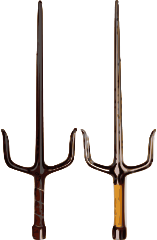Should amputees be allowed to compete with other martial artists?
I got an e-mail over the weekend from Eric Dexheimer, a reporter over at The Statesman, who was doing some research for an interesting article about an above-knee amputee MMA fighter, Jorge De Leon. The twist to the story is that despite covering his prosthesis with a protective foam and being physically fit for the event, the Texas Department of Licensing and Regulation fined the event organiser $5,500 and disqualified the event. To quote from Eric’s piece:
So, the question I rolled around in my head was – should amputees be allowed to compete with other martial artists?
The above is an interesting scenario – on the one hand, I think it’s awesome that he’s gone ahead and participated in an MMA match despite his disability, and feel quite strongly that he shouldn’t have been disqualified. On the other hand, knowing how much potential damage a prostheesis can inflict on a person, particularly some of the edges and parts relating to the knee, supporting titanium pole and so forth, I can see that there may be grounds in terms of safety of the prosthesis during a match.
In some ways, I’d argue that there simply being a prosthesis isn’t unsafe per se. The prosthesis is merely a tool that can used and manipulated as a weapon, no different to a knee, fist, elbow, etc. In fact, due to the greater degree of movement and kinetic energy that can be harnessed, it could be argued that these natural extensions of the body are no less safe than a prosthesis, it all comes down to the use thereof. For example, if I were to strike with a roundhouse kick, my prosthesis would likely cause a significant impact – however, due to the way kinetic energy can be manipulated via muscle and hard bone, I imagine that a roundhouse kick by a seasoned martial artist would arguably have greater impact. I have compared my kicking techniques to my instructors and other experienced martial artists I have trained with, and I would actually believe their strikes are actually more powerful than something I can generate. This is reflected in Eric’s article, noting that experienced athletic prosthetist Jan Stokosa found that while sparring with below-amputee Ron Mann, it was his real leg that caused greater impact compared to his prosthesis.
One of the disadvantages of a prosthesis compared to fully-functional limbs is that we don’t have the same degree of control compared to a physical leg owing to the lack of muscles, and this lack of control could well be grounds for arguing issues against its use (i.e. unintentional damage or injury due to the relative instability of the leg). Mind, contrary to that, I’ve seen some pretty scrappy MMA bouts, and I don’t think controlled striking is necessarily a universal component that all participants believe in; this does make sense in the spirit of MMA though, given its potential to simulate “real” combat, rather than point-based or light contact sparring quite common amongst “traditional” martial arts styles in the West. Mind, I certainly wouldn’t have the balls to compete in an MMA match, looks too full-on for my sensibilities!
As a point of comparison, if it’s relevant, whenever I spar with other martial artists I do two things – first up, I give them advanced warning to watch how they strike in case they unintentionally hurt themselves on the prosthesis. Secondly, I make it a habit not to actually strike using my prosthesis during sparring – this is more in line with my philosophy that I don’t believe I can control the leg to such a degree that I can guarantee there won’t be unnecessary impact to my sparring partner.
But MMA is arguably quite different to a lot of sparring I would do in class – if your body has a natural advantage (athletic, muscular, experience), does the presence of a prosthesis make much of a difference to the spirit of a match if it’s considered simply a function of the body, akin to the aforementioned attributes? When grappling arts like Brazilian Jujutsu were introduced into MMA competitions and proved an effective (and arguably essential) part of a combatants’ repertoire, the style wasn’t banned – rather, participants had to learn how the system worked and how to counter it. In that sense, is the presence of a prosthesis any different?
As an amputee, I can assure you that whilst there may be advantages to having a prosthesis during such a match, there are also a huge amount of disadvantages – balance, limited control, lactic acid buildup in the stump, incredible amount of energy expenditure to move/use the limb compared to an able-bodied competitor. The question is – do the disadvantages even out the advantages?
There’s also the fact that there aren’t many opportunities for amputee martial artists to be recognised and compete if they wish – I would be absolutely thrilled if karate or something similar would get introduced at a Paralympic level, as the only martial art currently available is judo, and participation is based on the basis of your eyesight-related disability. There is no avenue for amputees to compete.
I’m pretty on the fence with this one, hence why I’ve jumped back and forth on either side of the argument… I know it may be a little convoluted, but hopefully I’ve helped stimulate some discussion on the situation.
On a final note, for those interested in reading more about Ron Mann, check out the following sites:
- Disabled Sports USA – Athlete Profile: Martial Arts Pro Kicks Way to Top
- Xable.com – Ron Mann: Amputee Ulimate Fighter
He has also run some workshops and competitions at the Extremity Games – according to the website, the next one is happening next month in Texas. It’s definitely an event I’d love to go to, but putting aside the money factor (gotta love those Australian mortgages!), I’d want to get into more shape before thinking about heading over there to compete 😉
Huge props to Eric on his excellent report on this issue and for getting in touch – I just wish I checked my mail a little earlier so my response could have been more useful! I highly recommend you check it out to get the full story, it makes for a great read:

 Image sourced from Wikimedia Commons, original image by chris
Image sourced from Wikimedia Commons, original image by chris 


